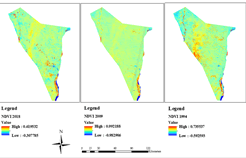Indexed In
- Open J Gate
- RefSeek
- Hamdard University
- EBSCO A-Z
- OCLC- WorldCat
- Publons
- International Scientific Indexing
- Euro Pub
- Google Scholar
Useful Links
Share This Page
Journal Flyer

Open Access Journals
- Agri and Aquaculture
- Biochemistry
- Bioinformatics & Systems Biology
- Business & Management
- Chemistry
- Clinical Sciences
- Engineering
- Food & Nutrition
- General Science
- Genetics & Molecular Biology
- Immunology & Microbiology
- Medical Sciences
- Neuroscience & Psychology
- Nursing & Health Care
- Pharmaceutical Sciences
Research Article - (2021) Volume 10, Issue 6
Detecting and Mapping the Influences of Vegetation Cover on Runoff and Torrents in Khartoum State, Sudan
Omer AA*, Hassan A and Hano A2Department of Natural Resources, Ministry of Agriculture, Sudan
3Department of Desertification and Desert Cultivation Studies, University of Khartoum, Khartoum North, Sudan
Received: 03-Jun-2021 Published: 24-Jun-2021, DOI: 10.35248/2469-4134.21.10.289
Abstract
The study was carried out in Omdurman and Sharg El-Neel to map and detect how the status of vegetation cover impacts on runoff and torrents. Satellite imageries of Landsat Thematic Mapper (TM) of 1994-2009 and Operational Land Imager/Thermal Infrared Sensor (OLI/TIRS) of 2018 were processed to derive accurate land use and land cover (LULC), using hybrid classification and normalized differences vegetation index (NDVI) of the study area. The results revealed changes in LULC classes during the study period (1994, 2009 and 2018). Omdurman area showed that the vegetation cover for the years 1994, 2009 and 2018 was 3.2%, 3.1% and 4.2% respectively. The respective sandy soil ratio was 18.2%, 34.9% and 27.6%. The water bodies were found to cover only 0.5%, 0.5% and 0.7% respectively. These results indicated that the area of vegetation cover was less than other LULC. Contrary, results from Sharg El-Neel revealed that the percentage of vegetation cover for the years 1994, 2009 and 2018 accounted for 31.4%, 41.3% and 24.7% respectively. The sandy soil ratios for these years were 26.3%, 14.8% and 38.3% respectively. The water bodies covered 0.5%, 0.6% and 1.3% respectively. The research concluded that changes in status of vegetation cover plays a role on water runoff and torrents events in the study areas. Thestudy recommends further studies to help produce robust plans that consist with LULC status, to minimize the water related risks and hazards.
Keywords
Parkinsonism remote sensing; GIS technology; Satellite imageries; Operational land imager; Thermal infrared sensor
Introduction
Natural hazards have increased lately, and attracted attention at regional and global levels [1]. Arid and semi-arid regions are highly of global concern because of their multi-dimensional issues [2]. These regions, including Sudan, are characterized by greater level of runoff and torrents that lead to degradation of the environment. Overall, climate change has influenced the magnitude and the distribution of the most important driving force of the hydrological cycle, i.e., rainfall [3] it is reported that some regions may receive more rainfall with dynamic patterns while others may become drier, and could result in a catastrophe under both situations [3]. In such conditions, the impact affects not only the livelihood of the people but also the surrounding environment [4]. Consequently, the environmental and economic potential of these regions will decline and may approach a non- reversible point i.e., desertification, abject poverty, if no mitigation measures are put into action [5-7]. Demir and Kisi
(2016) reported that these hazards and losses could be prevented and reduced by providing reliable information to the public, about the runoff and torrents risk. Definitely, the detection and mapping of vegetation cover and topographical parameters which influence the runoff and torrents are part of this information. Although, the vegetation cover provides protection of the soil against runoff and torrents, it also plays an important role in reducing runoff volumes and help to improve water quality in urban area [8,9].
Runoff is defined as movement of water over the Earth’s surface towards low lying areas, ending up in a catchment area [10]. Runoff and torrents create negative impacts on agricultural production, infrastructure and water quality across the world. The dynamics of overland flow and torrents formation is also controlled by topographic factors of terrain, slope, elevation, pedological and physical properties-permeability, texture and soil moisture [8-11].
Vegetationsare very important components of the ecosystem. Their destruction will have an adverse effect on ecosystems’ functional roles in the environment. Hence, there is a need to monitor, conserve and utilize vegetations sustainably [12]. Mapping land use and land change (LULC) are key spatial data affordably derived from remote sensing, and are necessary to identify runoff and torrents. It is stated that, higher vegetation cover results in better water-holding capacity, reduces runoff, and improves infiltration. This study aimed to investigate the role of vegetation and topography on the prevalence of runoffs and torrents at Omdurman and Sharg El-Neel localities in Sudan.
Material and Methods
Study Area
The Khartoum State demography comprises of seven localities viz Khartoum, Jebel Awlia, Bahri (Khartoum North), Omdurman, Karari, Um Badda, and Sharg El-Neel (East Nile). This State is considered as most populated State in Sudan. According to the 2008 population and housing census, 21% of the population is rural, 68% are urban and 11% are domestically displaced (Khartoum State Government, 2011; UNDP, 2011; CBS, 2008). Thus, Figure 1 showed study area.
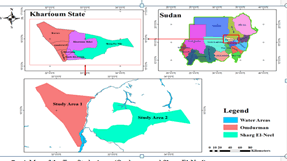
Figure 1: Map of the Two Study Areas (Omdurman and Sharg El-Neel)
The climate of Khartoum State is characterized by desert and semi desert ecological zone, known by its hot to very hot summer, short rainy season and warm to cold and dry winter (UNDP, 2011). The rainy season on the other hand, extends from July to October. The mean seasonal (June–September) rainfall value is about 121 mm with mean seasonal rainy days of 15. August is considered as a wettest month with 48.3% of the mean rainfall value (WMO, 2011). Rainfall in the State is characterized by storms of high intensity, but short duration. Khartoum State is characterized by very high potential evaporation rate (2.2-7.0 mm) per day and the evapotranspiration is far exceeding rainfall amount (Soil Conservation Administration, 2000). Khartoum State topography is almost flat, with slight slopes towards the river’s banks (Blue Nile, White Nile, and River Nile), and only interrupted by a few hills of rocky outcrops [13]. In the western part, the ripple topography is found due to the sand dunes. In contrast, topography is much solid in far eastern and northern parts. At the River Nile and its major tributaries that cross the study area, topography is permeated by the terraces and floors of the Nile valleys in the north-eastern part [13]. According to the Soil Conservation Administration (2000), the drainage pattern in Khartoum State is characterized by the dominance of the Nile, its tributaries and the ephemeral water courses (wadies). The streams have different directions. Upstream side is representing on the wadies which they are small and intensively changing to broad shallow, toward downstream till they reach the Niles. The delineation of the wadies’ catchment areas is difficult due to the flatness nature of terrain more over unsuitable scales of existing topographical maps.
Khartoum State lies in the semi-desert ecological zone that is divided into three subdivisions of vegetation or plants (Soil Conservation Administration, 2000): (a) Acacia tortilis-Maerua crassifolia desert scrub: occupy 90% of the State area where Acacia tortilis is the dominant woody species; (b) Semi desert grassland on sand: a small sub-zone occupying the extreme northwest of the State, where Acacia tortilis is the dominant woody species. Salvadora persica grows along the seasonal courses; (c) Semi desert grassland on clay: a small sub-zone occupying the southeast of the State. The woody species is Acacia mallifera growing along the shallow wadies’ courses. Moreover, along the banks and sometimes the islands of Blue Nile and River Nile, species like: Acacia nilotica, Acacia Syal, Ziziphus spinachristi, Fehderbi aalbida, and occasionally Balanites aegyptica and Tamarix nilotica on island are found (Soil Conservation Administration, 2000).
Data sources
The Landsat Thematic Mapper (TM) of 1994, 2009 and Landsat Operational Land Imager/Thermal Infrared Sensor (OLI/TIRS) of 2018 were downloaded from the Global Visualization Viewer (USGS-GloVis) via http://earthexplorer.usgs.gov/. The study area was entirely contained within three Landsat scenes (path 172- 173-174 and row 49). Image acquisition dates were selected based on availability of the images that is free of cloud in November and December. The detailed properties of Landsat data used in this study are presented in Table 1. Landsat sensors cover an area approximately 185*185 kilometer. These sensors vary in term of their band numbers and functions. They are covering the visible, near and middle infrared region of the electromagnetic spectrum. Therefore, the utility of Landsat imagery depending on the period and the nature of the study, and availability of the data to perform the desirable goals.
| Instrument | TM | OLI-TIRS |
|---|---|---|
| Landsat | 5 | 8 |
| Acquisition date | 1994 and 2009 | 2018 |
| Path/row | 172-173-174/49 | 172-173-174/49 |
| Spectral bands (µm) | 7 Bands | 11 Bands |
| Spatial resolution | 30*30 m | 30*30 m |
| Dynamic range (bit) | 8 bits | 12 bits |
Table 1: The characteristics of the imagery used in the study
Field work was carried out during the dryseason March, 2019. The field work was established to increase the understanding of the pattern of land use/land cover as well as the earth topography of the study area. The data were collected from different sites determinate from unsupervised classification images of the study area. Seven localities viz Khartoum, Jebel Awlia, Bahri (Khartoum North), Omdurman, Karari, Um Badda, and Sharg El-Neel (East Nile) were registered by using Global Positioning System device to allow further integration with the spatial data in a geographic information system (GIS) for image classification. The following information was collected from study area: (a) Identification of the status of LULC; (b) Detection of the physical aspects of soil, topography, and vegetation cover. Sudan Metrological Authority (WMO) provided data of annual rainfall for the period 1961- 2018, to identify rainfall rates for the different periods of the study area.
Methodology
Different approaches for image processing were used to extract information for mapping vegetation cover. The imagery used in this research is already geometrically corrected. In addition, the research area is almost a flat terrain, rendering geometric correction unnecessary. Atmospheric condition at the time acquisition was very good ensuring more satellite orbit and good imaging quality.
Image enhancement procedures were done to multi-date satellite images in order to increase visual discrimination between features and to improve interpretability. So as spatial enhancement, the histogram equalization was applied to increase the data quality and a set of band combination were tested to produce the best color composite for identifying the major classes in the study area, using ERDAS 8.5 software.
Visual image interpretation was done by using characteristics of features including tone, texture, size, shape and association. Moreover, different band combination was used in order to derive useful information for LULC classification and interpretation. The used band combinations were 4, 3 and 2 for TM, and 5, 4 and 3 for OLI/TIRS.
A hybrid classification with combination of unsupervised classification and field data was used prior to the field survey to identify the numerous spectral classes. Also, the method was to represent the LULC information classes to be differentiated in a supervised classification Figures 2 and 3, Table 2.
| Land classes | Cover characterization feature |
|---|---|
| Vegetation | Include areas currently under crop, and land under preparation, shrub and tress. |
| Water bodies | Blue Nile, White Nile and watershed. |
| Bare land | Areas of land that already have bare either due to erosion or misuses especially overgrazing and deforestation. |
| Sandy Soils | Sand fixed Sand dunes. |
| Clay Soils | Clay and Gardood Soil |
| Urban area | Settlements (Build-up houses). |
Table 2: LULC Types Identified in the Study Area (Omdurman and Sharg El-Neel)
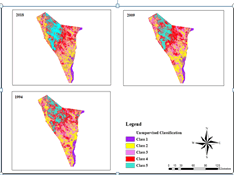
Figure 2: LULC classification and interpretationof the images of Omdurman
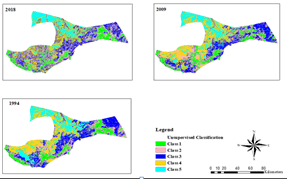
Figure 3: LULC classification and interpretation of the images of Sharg El-Neel
In this technique, the change in image is obtained by taking the differences of the
Vegetation indices computed for multiple dates of images. The normalized difference vegetation index (NDVI) with value range of -1 to 1 was computed for each image as reported by Mouat, et al (1993) and Wilsona and Sader (2002):
NDVI=((NIR−RED)/(NIR+RED)) (1)
Where:
NIR is the near-infrared band response and
RED is the red band response for a given pixel.
The difference between the vegetation indices computed separately for eachimage gives a measure of the vegetation change
Results and Discussion
Land use land cover of Omdurman area
Land use land cover (LULC) results of the classified images in 1994, 2009 and 2018 show six classes. The dominant LULC types extracted from these images were bare lands, clay soils, sandy soils, vegetation, settlements, and water bodies. In 1994, the largest portion of 40.2% of the total area was covered by clay soils. Bare lands, sandy soils, vegetation, settlements and water
bodies accounted for 35.5%, 18.6%, 3.2%, 2.1% and 0, 5% of the total area respectively (Figure 4 and Table 3).
| Years | 1994 | 2009 | 2018 | LULC Changes | |||||
|---|---|---|---|---|---|---|---|---|---|
| LULC classes | (ha) | (%) | (ha) | (%) | (ha) | (%) | 1994-2009 | 2009-2018 | 1994-2018 |
| Vegetation Cover | 24906.7 | 3.2 | 23600.9 | 3.1 | 32604 | 4.2 | -130508 | 9002.9 | 7697.1 |
| Sandy Soils | 143586 | 18.6 | 269468 | 34.9 | 213382 | 27.6 | 125882 | -56086 | 69796 |
| Clay Soils | 310723 | 40.2 | 213652 | 27.6 | 163485 | 21.2 | -97071 | -50167 | -147248 |
| Bare Lands | 274053 | 35.5 | 231619 | 30 | 321493 | 41.6 | -42434 | 89874 | 47440 |
| Water Bodies | 3710.16 | 0.5 | 4185.99 | 0.5 | 5213.7 | 0.7 | 475.83 | 1027.71 | 1503.54 |
| Settlements | 15943.4 | 2.1 | 30396.1 | 3.9 | 36745 | 4.8 | 14452.7 | 6349.1 | 20801.8 |
Table 3: Changes in the LULC Areas of Omdurman Over 1994, 2009 and 2018
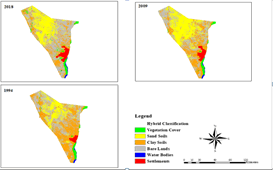
Figure 4: LULC Classification of Omdurman Area Over 1994, 2009 and 2018.
Vegetation cover decreased from 1994 to 2009, yet increasedfrom 2009 to 2018. Sandy soil area increased in the period of 1994 to 2009 and decreased in 2009 to 2018. Clay soils area decreased throughout the years. The bare lands area decreased in the period of 1994 to 2009 and increased from 2009 to 2018. Additionally, water bodies and settlement area were increased between studied years. Overall, between 1994 and 2018 vegetation, sandy soils, bare lands, water bodies and settlements increased by 7697.1 ha, 69796 ha, 47440 ha, 1503.5 ha and 20801.8 ha respectively, while clay soils decreased by 147248 ha Table 3.
Land use land cover of sharg el-neel area
The study finding of the LULC of the classified image in 1994, 2009 and 2018 depicted six classes. The dominant LULC classes were vegetation, sandy soils, clay soils, bare lands, water bodies, and settlements. The dominant land cover type in 1994 was vegetation cover estimated with 31.4% of total area, followed by sandy soils of 26.3%. Clay soils, bare lands, water bodies, and settlements counted 22.4%, 19.4%, 0.5% and 0.1% of the total area, respectively. In 2009, the largest portion of land was vegetation area representing 41.3%, followed by bare lands of 24.9%. Clay soils, sandy soils, water bodies, and settlements covered 18.2%, 14.8%, 0.6% and 0.1% of the total area, respectively. Regarding 2018, sandy soil is the dominant land cover type covering 38.3%, followed by vegetation cover 24.7%. Clay soils, bare lands, water bodies and settlements estimated with 21.3%, 14.2%, 0.2% and 1.3% of the total area, respectively Vegetation and bare lands increased through the period of 1994 and 2009, but decreased in 2009 to 2018. Sandy soils, clay soils and settlements areas increased in 1994 to 2009, but decreased from 2009 to 2018. Water bodies increased during study years. Overall, the period between 1994 and 2018 which includes vegetation, clay soils and bare lands decreased by 48281 ha, 7582 ha and 37634 ha respectively? Contrary sandy soils, settlements and water body’s area increased by 86845 ha, 515.61 ha and 6136.11 ha respectively, (Figure 5 and Table 4).
| Years | 1994 | 2009 | 2018 | LULC Changes | |||||
|---|---|---|---|---|---|---|---|---|---|
| LULC classes | (ha) | (%) | (ha) | (%) | (ha) | (%) | 1994-2009 | 2009-2018 | 1994-2018 |
| Vegetation Cover | 227801 | 31.4 | 299937 | 41.3 | 179520 | 24.7 | 72136 | -120417 | -48281 |
| Sandy Soils | 190838 | 26.3 | 107722 | 14.8 | 277683 | 38.3 | -83116 | 169961 | 86845 |
| Clay Soils | 162326 | 22.4 | 132216 | 18.2 | 154744 | 21.3 | -30110 | 22528 | -7582 |
| Bare Lands | 140614 | 19.4 | 180933 | 24.9 | 102980 | 14.2 | 40319 | -77953 | -37634 |
| Settlements | 849.06 | 0.1 | 675.45 | 0.1 | 1364.67 | 0.2 | -173.61 | 689.22 | 515.61 |
| Water bodies | 3310.47 | 0.5 | 4255.02 | 0.6 | 9446.58 | 1.3 | 944.55 | 5191.56 | 6136.1 |
Table 4: Changes in the LULC Areas of Sharg El-Neel Over 1994, 2009 and 2018
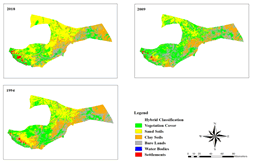
Figure 5: LULC Classification of Sharg El-Neel Area Over 1994, 2009 and 2018
NDVI findings
NDVI of omdurman area: The results show that the highest NDVI value for different images was recorded in 2009 (0.9 to
-0.3), while 1994 and 2018 respectively low (0.7 to -0.5, 0.6 to
-0.3). In this view NDVI result (Figure 6) can be explained. The red color shows the high value of vegetation index, whereas the blue color validated the low value. On the other hand, NDVI map showing four classes (dense/moderate vegetation, low dense vegetation, no vegetation, and bare lands). The area of the largest dense/moderate vegetation in 1994 covered about 69517.2 ha, while 2018 and 2009 was the lowest area respectively (15979, 12259 ha). Moreover, the class of no vegetation cover showed the largest area in 2018 approximately 342117 ha, and the 2009, 1994 covered area about (341005, 339328 ha) respectively presented in (Figure 7 and Table 5).
| Years | 1994 | 2009 | 2018 |
|---|---|---|---|
| NDVI Classes | (ha) | (ha) | (ha) |
| Dense/Moderate Vegetation | 69517.2 | 12259.1 | 15979 |
| Low Dense Vegetation | 288962 | 307603 | 408569 |
| No Vegetation Cover | 339328 | 341005 | 342117 |
| Water | 4903.02 | 51220.89 | 6257.7 |
Table 5: Area of NDVI Value of Omdurman for the Years 1994, 2009 and 2018
Figure 6: NDVI Value of Omdurman for the Year 1994, 2009 and 2018
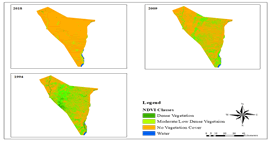
Figure 7: NDVI Classes of the Images Omdurman for the Years 1994, 2009 and 2018
NDVI of sharg El-Neel area: The NDVI finding showed that the highest value was in image of 2009 (0.9--0.9) and the lower value was 0.6 to -0.6, and 0.5 to -0.3 for 1994 and 2018, respectively. In Figures 8 and 9 the high value of vegetation clarified with red color, while the blue color shows the low value. NDVI result (Figure 8) shows four classes (dense/moderate vegetation, low dense vegetation, no vegetation cover, and bare lands). The area of the largest dense/moderate vegetation in 2018 covered about 82338.1 ha, while 1994 and 2009 was the lowest area covered respectively (14707.6, 10214.9 ha). Furthermore, the class of no vegetation presented the largest area in 2009 approximately 413021 ha, and the 1994, 2018 covered area about (411294,
176119 ha) respectively (Table 6).
| Years | 1994 | 2009 | 2018 |
|---|---|---|---|
| NDVI Classes | (ha) | (ha) | (ha) |
| Dense/Moderate Vegetation | 14707.6 | 10214.9 | 82338.1 |
| Low Dense Vegetation | 241468 | 170533 | 339635 |
| No Vegetation Cover | 411294 | 413021 | 176119 |
| Water | 58268.6 | 34663.8 | 30928 |
Table 6: Area of NDVI of Sharg El-Neel for the years 1994, 2009 and 2018
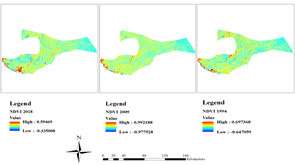
Figure 8: NDVI Images of 1994, 2009 and 2018 of Sharg El-Neel Study Area
Study Area
Influences of vegetation cover on runoff and torrents: Vegetation cover status throughout the study period of 1994, 2009 and 2018 of Omdurman covered small part from the total area, comparison with extension in bare land and sandy soil area. Vegetation cover in Sharg El-Neel presented largest area in 1994 and 2009 and showed marked decrease in 2018. A comparison with increasing in sandy soil, clay soil and bare land, shows that these changes were possibly affected by fluctuation in rainfall amounts and the reduction maybe affected by anthropogenic activities and population pressure which cause increase in bare land during the last year, as supported by Gadiga [12]. The author stated that this resource is being affected by human activities and global climatic variation/change affecting the progress of vegetation. The reduction of vegetation cover in the study area exposed the land surface to runoff and torrents events which have led to adverse effects on the agricultural land, infrastructure and environmental damages. In addition, human induced activities altered natural landscape i.e., expansion of built-up area, decreasing in grassland, forest and shrub land (Fracture, 2007).
For example, four sections were taken from Omdurman area for identification vegetation cover status which including LULC section (sandy soil, clay soil and bare land), contour line section with elevation 450 m, slope section range from 0 to 89.999 and aspect section distinguished to flat areas (-1), North (0-22.5) Northeast (22.5-67.5), East (67.5-112.5), Southeast (112.5-157.5),
South (157-202.5), Southwest (202.5-247.5), West (247.5-292.5),
Northwest (292.5-337.5), North (337.5-360). Meanwhile, Sharg El-Neel consist of vegetation, sandy soil, clay soil and bare land over at elevation of 500 m and slope range from 0 to 89.999 degree and slope direction was flat areas (-1), North (0-22.5) Northeast (22.5-67.5), East (67.5-112.5), Southeast (112.5-
157.5), South (157-202.5), Southwest (202.5-247.5), West (247.5-
292.5), Northwest (292.5-337.5), North (337.5-360). The study results indicate that vegetation cover status of Omdurman area is nonexistent in area with high elevation on different slope degrees. While found vegetation cover in Sharg El-Neel area over elevation 500 m. Therefore, the topography has greater impact on existence and development of vegetation. In addition, soil type and climate variation have significant role in growth plant community in study area.
Because of fluctuation of rainfall, lack of protection infrastructure and irrational land exploitation, Khartoum State (Omdurman and Sharg El-Neel) was and is still vulnerable to frequent runoff and torrents. The path of runoff and occurrence of torrents depend on rainfall intensity and duration during the storm. High rainfall intensity over sparsely vegetated and steep hilly surface generates a rapid onset of runoff. Where the soil layer is shallow or compacted higher volume of runoff can be produced with the same amount of rainfall depth [14].
Conclusion
This work presented the application of remote sensing and geographic information system. Per the research objectives, LULC change was identified for 1994, 2009 and 2018 to established significant changes within the area. Result shows that the most dominant changes observed are vegetation cover, bare land, sandy soil, clay soil and settlements and water bodies for both Omdurman and Sharg El-Neel areas. Vegetation cover occupies the small area of Omdurman represented 3.2%, 3.1% and 4.2% for the periods 1994, 2009 and 2018 respectively. Contrary, vegetation cover in Sharg El-Neel covered largest area estimated with 31.4% 41.3% and 24.7% respectively. Also, the result showed large conversion in vegetation cover from 2009 to 2018, as compared with increase in sandy soil area which represent 26.3%, 14.8% and 38.3% for 1994, 2009 and 2018 respectively. The research concluded that the changes over time of LULC and natural terrain of the land in addition to rainfall events significantly alter hydrological process which causes runoff and torrents on the study area.
REFERENCES
- Al Saud M. Use of remote sensing and gis to analyze drainage system in flood occurrence, jeddah-western saudi coast. Drainage systems. 2012; 7:139-64.
- Howard AD. Thresholds and bistable states in landform evolution models. Eos Trans Agu. 1996;77:17.
- IPCC. Contribution of Working Groups I, II and III to the Fourth Assessment Report of the Intergovernmental Panel on Climate Change. 2007.
- Mahmoud WH, Elagib NA, Gaese H, Heinrich J. Rainfall conditions and rainwater harvesting potential in the urban area of Khartoum. Resources, Conservation and Recycling. 2014;91:89-99.
- Kassas M. Desertification: A general review. J Arid Environ.1995; 30(2):115- 128.
- Reynolds JF, Smith SDM. Do humans cause deserts? Global desertification: do humans cause deserts. 2002:1-21.
- Wickens G. Has the Sahel a future?. J Arid Environ. 1997; 37(4): 649â??663.
- Kinga I. A GIS and remote sensing based research on the cluj-napoca municipality urban hydrology. â??Babe Å?-Bolyaiâ? University Cluj-Napoca. 2015
- Penna D, TrompVan Meerveld H J, Gobbi A, Borga M, Dalla Fontana G. The infuence of soil moisture on threshold runoff generation processes in an alpine headwater catchment. Hydrol Earth SystSci. 2011(15), 689â??702.
- Dimitriou E. Overland flow. Encyclopedia of agrophysics. Springer Netherlands, Dordrecht. 2011:536.
- Dunne T. Relation of field studies and modeling in the prediction of storm runoff. Journal of Hydrology. 1983; 65(1-3): 25-48.
- Gadiga BL. Monitoring the spatio-temporal dynamics of vegetation cover in Mubi Region, Adamawa State, Nigeria. J Geo Inf Sys. 2015; 7(06): 598.
- Abdalla A, Fashir HH, Ali DF. Validation of recent GOCE/GRACE geopotential. J Geodetic Sci. 2012: 2(2): 88-97.
- Pilgrim DH, Chapman T, Doran DG. Problems of rainfall-runoff modelling in arid and semi-arid regions. Hydrolog Sci J. 1998; 33(4):379-400.


